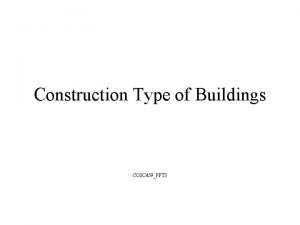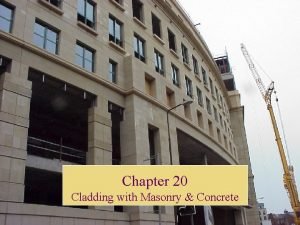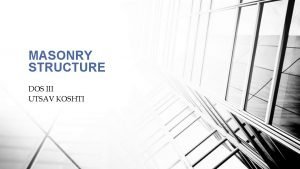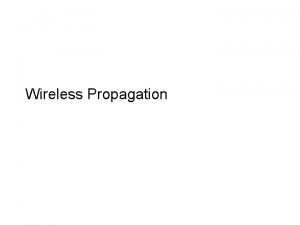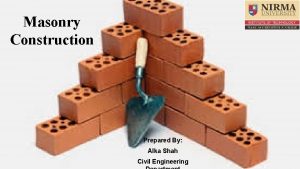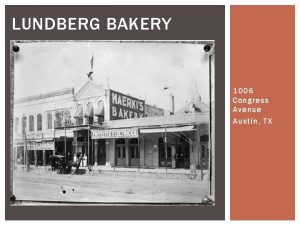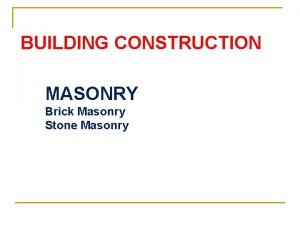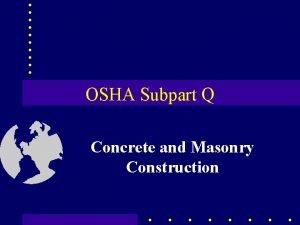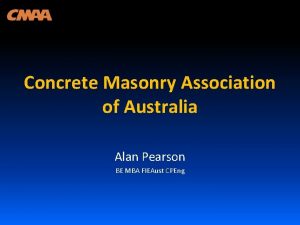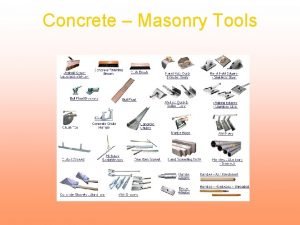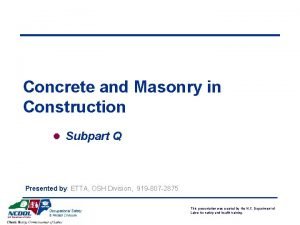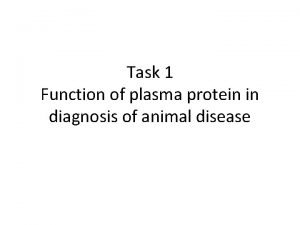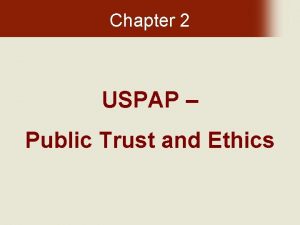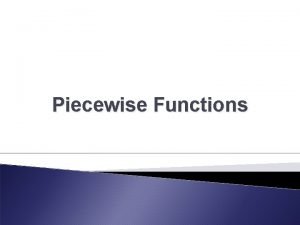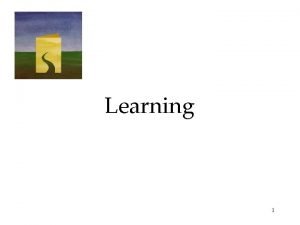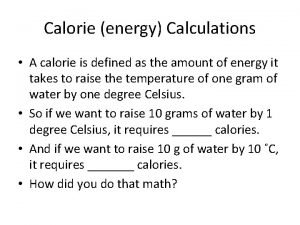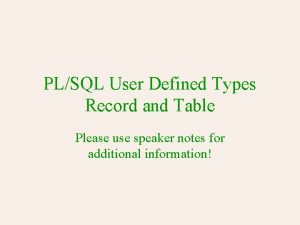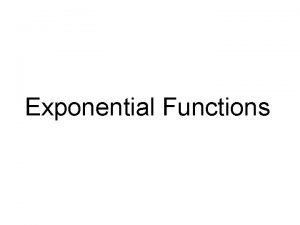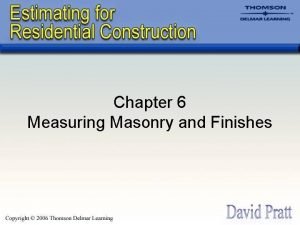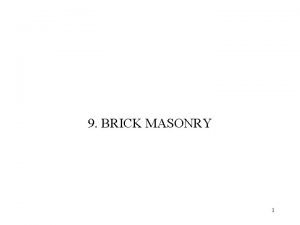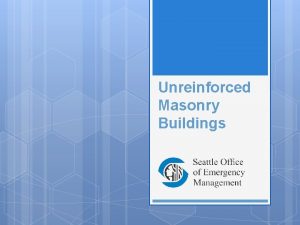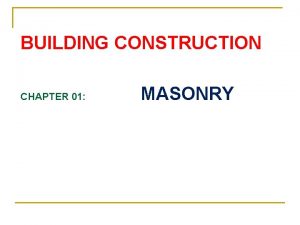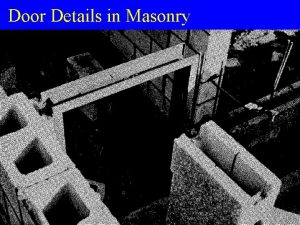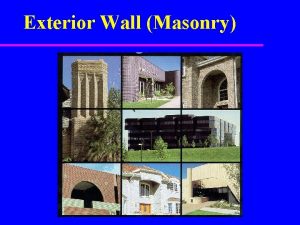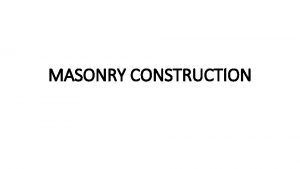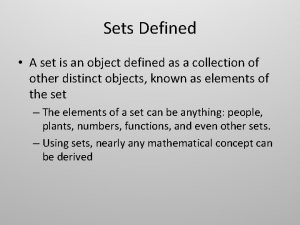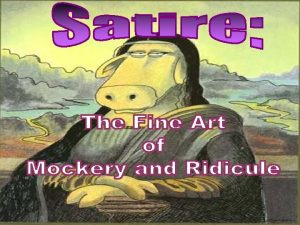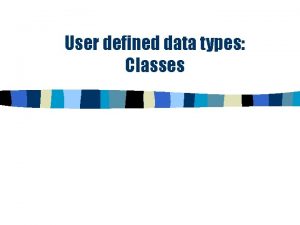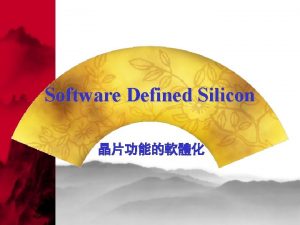MASONRY 3 rd A MASONRY is defined as































- Slides: 31

MASONRY 3 rd A

• MASONRY is defined as the art of construction in which building units, such as clay bricks, sand-lime, bricks, stones, Pre-cast hallow concrete blocks, concrete slabs, glass bricks, combination of some of these building units etc. are arranged systematically and bonded together to form a homogeneous mass in such a manner that they can with stand point to other loads and transmit then through the mass without fail or disintegration. Masonry can be classified into the following categories. • Stone masonry • Brick masonry • Hallow block concrete masonry • Reinforced masonry • Composite masonry

TERMS IN MASONRY • • Masonry work: Works that are executed with masonry materials is the masonry work. Most commonly used masonry materials are brick, concrete block and stone. Beside these, there are some other masonry materials – glass block, terra cotta, structural clay tile etc. Veneer: When masonry is used on non masonry wall as a facing material that is called veneer. Veneer is normally one unit in thickness. Wythe: One unit thick vertical masonry wall is called wythe. Single-wythe wall: Masonry wall can be one unit or more in thickness. Single-wythe wall means it’ll be only one unit in thickness and it won’t be anchored with backing wall. Double-wythe wall: If the walls are two units in thickness that is called double-wythe wall. Collar joint: Double-wythe wall contains a gap between wythes. This gap is normally filled with cement-mortar. If the thickness of gap is less than one inch that is called collar joint. Cavity and Cavity wall: If the thickness of gap between wythes is wider than one inch that is called cavity. Using steel reinforcement is must if the cavity is filled with cementmortar. Cavity can also be left unfilled. If the cavity is left unfilled of a double-wythe wall that is called cavity wall.


• Bat/batt: Half or smaller piece of a full size masonry block is called bat/batt. • Bed joint: Horizontal joint of a masonry wall is the bed joint. • Buttering: Buttering means placing mortar on masonry block with trowel. • Closure: Closure is the small piece of masonry block used at the end of masonry wall to maintain bond pattern. • Grout: A liquid mix of cementitious material, fine aggregate and water. • Jamb: Vertical sides of masonry wall opening is called jamb. Such as both sides of window and door opening

Brick masonry

• BRICK MASONRY The art of laying bricks in mortar in a proper systematic manner gives homogeneous mass which can withstand forces without disintegration, called brick masonry

Types of bricks Ø Traditional bricks (Size=21 -25 cm in length, 10 -13 cm in width & 7. 5 cm in height) Commonly adopted is 23 x 11. 4 x 7. 5 Ø Modular bricks (Size=20 x 10 cm with mortar & 19 x 9 x 9 cm)

Technical terms used in brick masonry • Header : Brick which is laid with its length perpendicular to the face of the wall. • Stretcher : Full brick which is laid with its length parallel to the face of the wall. • Course : Horizontal layer of brick. • Header course : Course of brick work fully composed of header • Stretcher course : Course of brick work fully composed of stretchers. • Closer: Portion of brick cut in such a manner that one long face remains uncut. • King closer: Brick is cut in such a way that the width of its end is half of full brick.


• Queen closer: Brick is half as wide as a full brick. • Half Bat: Portion of brick cut half across the width. • Bevelled closer: It is similar to king closer with the only difference that the whole length of he brick is bevelled. • Soldier: Laid vertically with the long narrow side of the brick exposed. • Sailor: Laid vertically with the broad face of the brick exposed. • Rowlock: Laid on the long narrow side with the short end of the brick exposed.

Principals to be observed in brick masonry construction Ø Bricks used should be hard, durable, sound and well burnt with uniform size shape and color. Ø The bricks should be soaked in clear water before the use for a suitable period so that the water just penetrates the full depth of the bricks. Ø The bricks should be laid on full bed of mortar. Ø Brick work should be carried uniformly. Ø Plastering should be done after 28 days of curing of brick masonry. Ø Finished Brick masonry structure's should be kept wet for at least 7 days.

Ø All the joints should be properly flushed and filled with mortar so that no cavity is left in between. Ø In case of walls two bricks or more in thickness, the joints should be grouted at every course in addition to bedding with mortar. Ø No brick bats should be used in the work except when it is absolutely necessary for obtaining the specified bond. Ø Brick work is generally laid in English Bond. Ø Only specified mortar of good quality should be used.

BONDS

IMPORTANCE OF BONDING The manner of overlapping bricks for construction of wall is called Brick Bond. Many types of bonds are used in different ways for construction of brick walls or brick pillars. Good brick bonds can ensure the strength of a building and aesthetic beauty of brick walls, brick pillars and entire brick works depends on the quality of bonds. Thus Bond in Brickwork is of utmost importance.

DIFFERENT SYSTEMS OF BONDING • • The following are the principal forms of bonding : English Double Flemish Single Flemish Heading Stretching Rat trap bond Garden Wall

RULES FOR GOOD BRICK BONDING • • Uniform in size. Bricks arranged uniformly throughout the wall. Bats are used as little as possible. The vertical joints in every other course should be vertically over one another.

ENGLISH BOND q The facing bricks are laid in alternate courses of headers and stretchers. q Queen-closer inserted next to quoin-headers to produce overlap. q English bond is the strongest. a. Avoids continuous vertical joints. DISADVANTAGE: q Penetration of damp through transverse joints. q Appearance not as good as Flemish bond.


FLEMISH BOND 1. Double Flemish bond 2. Single Flemish bond Double Flemish is shown in the figure. q The headers and stretchers alternate in each course. q The lap is produced by placing a queen-closer next to the quoinheader in every course. q. Flemish bond is weaker than English bond. Fig. 3


Single Flemish Bond: is a species of bond in which q Placement of double Flemish bond on the face of the walls. q The rest of the wall is built in English bond. q Used for walls requiring a good appearance and strength. q Not employed for wall less than 1 and a half bricks thick. ADVANTAGES OF FLEMISH BOND: q It is highly economical. q Walls one brick in thickness are easier to produce a fair face on both sides in Flemish than English bond. q The appearance of Flemish bond is more appealing to eye than that of English bond.

HEADING OR HEADER BOND Header is the shorter square face of the brick which measures 9 cm x 9 cm. Header bond is also known as heading bond. In header bonds, all bricks in each course are placed as headers on the faces of the walls. While Stretcher bond is used for the construction of walls of half brick thickness whereas header bond is used full brick thickness for the construction of walls with full brick thickness

HEADER COURSE

STRETCHING OR STRETCHER BOND q Bricks are laid in stretchers, as in the figure below. q Used in walls of half-brick in thickness. q Due to its constant occurrence in the last position it is also called Chimney Bond.

STRETCHER BOND

GARDEN-WALL BOND q Used for 9 inch walls. q Used when a fair face is required on both sides. q Wall is composed of three or four courses of stretchers alternating with one of headers, as in the figure below.

RAT TRAP BOND q It is made by placing the bricks on their sides having a cavity of 4″ (100 mm) q Alternate course of stretchers and headers. q It is still used in India as an economical bond.

THE ADVANTAGES OF RAT TRAP BOND: It is highly economical because: q Can make a wall of one brick thickness with fewer bricks than a solid bond. q Strength is equal to the standard 10″ (250 mm) brick wall, but consumes 20% less bricks. q Cost saving on material is 26% as compared to the traditional 10″ brick wall. q Maintains thermal comfort inside the building due to air medium. q Bricks aligned on both sides, plastering not required. q It is quite strong as building constructed about 40 years ago still does not show any signs of distress.

Stacked Bond - Bricks stacked on top of each other in vertical rows

Rowlock laid on face, end visible Stretcher - long dimension horizontal & face parallel to the wall Soldier - Laid on its end, face parallel
 Construction type iia
Construction type iia It is collection of well defined objects
It is collection of well defined objects Cmu cladding
Cmu cladding Hydrostatic pressure dam examples
Hydrostatic pressure dam examples King closer brick
King closer brick What is masonry
What is masonry Hata model formula
Hata model formula Throating in stone masonry
Throating in stone masonry String course in stone masonry
String course in stone masonry Articulated brickwork
Articulated brickwork Cramped joint in stone masonry
Cramped joint in stone masonry Lundberg masonry
Lundberg masonry Chamfered ashlar masonry
Chamfered ashlar masonry Support for precast concrete can be removed
Support for precast concrete can be removed Limited access zones around masonry wall construction
Limited access zones around masonry wall construction Barry cargill masonry
Barry cargill masonry Masonry venice fl
Masonry venice fl Concrete masonry association of australia
Concrete masonry association of australia Common float in masonry
Common float in masonry Employers must not place construction loads
Employers must not place construction loads Employers must not place construction loads
Employers must not place construction loads Hyperalbuminaemia
Hyperalbuminaemia In uspap the word ethics is defined
In uspap the word ethics is defined Extrication is defined as
Extrication is defined as Id is based on moral values
Id is based on moral values Piecewise function meaning
Piecewise function meaning Relatively permanent law
Relatively permanent law Calorie is defined as
Calorie is defined as Relic boundary definition
Relic boundary definition Evolutionary theory of motivation
Evolutionary theory of motivation Sql user defined table
Sql user defined table Transformations of exponential functions
Transformations of exponential functions
